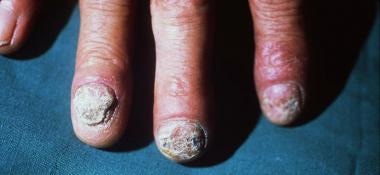Background
Chronic mucocutaneous candidiasis (CMC) refers to a heterogeneous group of disorders characterized by recurrent or persistent superficial infections of the skin, mucous membranes, and nails with Candida organisms, usually Candida albicans. These disorders are confined to the cutaneous surface, with little propensity for systemic dissemination. CMC does not represent a specific disease, but rather a phenotypic presentation of a spectrum of immunologic, endocrinologic, and autoimmune disorders. The unifying feature of these heterogeneous disorders is impaired cell-mediated immunity against Candida species.
The image below depicts CMC of the nails.
Pathophysiology
C albicans is an opportunistic yeast that is part of the normal flora of the gastrointestinal tract, skin, and mucous membranes. The fungus can exist in the yeast, the mycelial (pseudohyphal), or the chlamydospore phase. Invasive disease is rare; however, when it occurs, it is usually associated with mycelial elements. Several host factors are important in defending against infection by candidal organisms. Healthy, intact skin that continuously desquamates and regenerates is usually an effective initial barrier. An intact immune system is critical for keeping this opportunistic organism at bay.
Chronic mucocutaneous candidiasis (CMC) is associated with a defect in cell-mediated immunity that may either be limited to Candida antigens or be part of a more general immune abnormality. Recent data suggest alterations in cytokine production in response to Candida antigens. These alterations include decreased interleukin (IL)–2 and interferon-gamma levels (TH 1 cytokines) and increased IL-10 levels in some studies. [1, 2] Patients who lack T-cell immunity (eg, those with severe combined immune deficiency syndrome or DiGeorge syndrome) or patients with severely impaired T-cell function (eg, patients with AIDS) are susceptible to chronic candidal infections. Defects in humoral immunity are not commonly observed in patients with CMC, and patients with antibody deficiencies are not particularly prone to candidiasis.
A study of peripheral-blood mononuclear cells from 14 patients with autosomal dominant CMC found poor production of interferon-gamma, IL-17, and IL-22. Gene sequencing identified mutations in signal transducer and activator of transcription 1 (STAT1), leading to defective immune responses in type 1 and type 17 helper T cells. [3, 4, 5]
Etiology
Chronic mucocutaneous candidiasis (CMC) occurs in a heterogeneous group of patients with a wide spectrum of immune dysregulation, ranging from Candida -specific decreased immunity to a broader immune defect.
Epidemiology
Race
No racial predilection is reported for chronic mucocutaneous candidiasis (CMC) , although autoimmune polyendocrinopathy-candidiasis-ectodermal dystrophy (APECED) is most prevalent in Finnish, Sardinian, and Iranian Jewish populations.
Sex
The male-to-female ratio for CMC is equal.
Age
CMC usually manifests in infancy or early childhood (60-80% of cases), with a mean age of onset of 3 years. Delayed or adult onset of the disease is reported and can be associated with thymoma, myasthenia gravis, and bone marrow abnormalities.
Prognosis
Chronic mucocutaneous candidiasis (CMC) is a chronic disease, and recurrent and relapsing superficial infections with Candida organisms should be expected. Life expectancy is generally normal but significant morbidity is associated with the chronic nail and mucocutaneous infections and associated endocrine and/or autoimmune disease. In rare cases, premature death occurs secondary to disseminated Candida infection, sepsis, pneumonia, or mycotic aneurysms.
CMC is not associated with a high degree of mortality because disseminated invasive candidal infections are rare. In isolated CMC, the prognosis is good; however, the significant morbidity is related to chronic and persistent skin, nail, and mucous membrane candidal infections. The risk of mycotic aneurysms, while low, remains a real possibility. [6] In a subset of patients, malignant thymomas or cancers of the oral cavity and digestive tract may occur. Patients with autoimmune polyendocrinopathy-candidosis-ectodermal dystrophy (APECED) have significant morbidity from endocrinopathies or other autoimmune diseases associated with this condition. Several cases of Pneumocystis carinii pneumonia in patients with CMC are reported in the literature.
Patient Education
Patients should be aware of the chronic, recurrent nature of their disease and the current paucity of effective long-lasting therapies.
For patient education resources, visit the Infections Center. Also, see the patient education article Candidiasis (Yeast Infection).
-
Thickened, fragmented, hyperkeratotic nails and erythematous periungual skin. Courtesy of Walter Reed Army Medical Center.
-
Crusted hyperkeratotic plaques on and around the nose. Courtesy of Walter Reed Army Medical Center.
-
Crusted hyperkeratotic plaques on eyebrow, forehead, and scalp. Courtesy of Walter Reed Army Medical Center.










